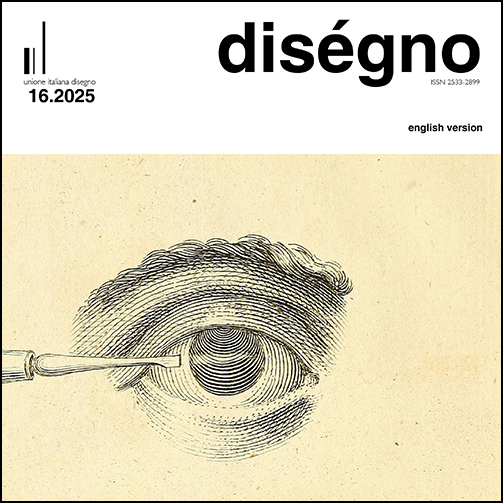Representation Systems and Theoretical Design Frameworks
DOI:
https://doi.org/10.26375/disegno.16.2025.16Keywords:
drawing, projective systems, language representation, design intent, compositional theoriesAbstract
This contribution, developed within the broader context of a reflection on the role of drawing in the conceptual phase of the design process, analyzes how the adoption of a specific analogical projective representation system aligns with adherence to a particular theoretical orientation in composition.
As a mediator between the design concept and its gradual final configuration, drawing becomes an expression of design intent. It is an essential tool for the designer, who can explore examples and solutions drawn from historical tradition and the reference context, reinterpreting and enriching them with new potential and meaning. Drawing is not a neutral tool, but is always linked to the architectural culture that produces it, shaping design choices. This highlights the non-neutrality of representation as a form of language, linked both to the cultural attribution of meaning to the graphic sign anchored in a specific historical moment and to the ways in which the author employs it to convey a design intention. Today, technological evolution has led to the proliferation of a wide range of digital tools capable of influencing design practice itself. The research to which this contribution refers has shown how digital technologies can restore a central role to drawing in the conceptual phase of design, offering designers innovative tools to explore new creative possibilities.
References
Boeri, E. (2024). Luigi Carlo Daneri 1900-1972. Abitare il paesaggio. Milano: Silvana Editoriale.
De Fusco, R. (1990). Design: una teoria ermeneutica del progetto. In Op.cit. Selezione della critica d’arte contemporanea, n. 79, pp. 18-27. <https://opcit.it/cms/?p=145> (consultato il 5 maggio 2025).
De Rubertis, R. (1994). Il disegno dell’architettura. Roma: La Nuova Italia Scientifica.
De Simone, M. (1990). Disegno, rilievo, progetto. Il disegno delle idee, il progetto delle cose. Roma: La Nuova Italia Scientifica.
Durand, J.-N.-L. (1809). Précis des leçons d’architecture données à l’École royale polytechnique (Vol. I). Parigi: Firmin Didot.
Durand, J.-N.-L. (1813). Nouveau précis des leçons d’architecture données à l’École impériale polytechnique: premier volume, contenant trente-deux planches (Vol. I). Parigi: Firmin Didot.
Durand, J.-N.-L. (1821). Partie graphique des cours d’architecture faits à l’École Royale Polytechnique depuis sa réorganisation; précédée d’un sommaire des leçons relatives à ce nouveau travail (Vol. I). Parigi: Firmin Didot.
Galofaro, L. (1999). Digital Eisenman. An Office of the Electronic Era. Svizzera: Birkhäuser.
Gentili Tedeschi, E. (1954). Unità residenziale “Villa Bernabò Brea” a Genova. In Casabella, n. 204, pp. 49-61.
Giordano, A. (2002). Dal secolo dei Lumi all’epoca attuale (Vol. 3). La geometria nell’immagine. Storia dei metodi di rappresentazione. Torino: UTET.
Hoffman, D. (1994). The receding horizon of Mies. Work of the Cranbrook Architecture Studio. In G. Baird (Ed.). The presence of Mies. New York: Princeton Architectural Press.
Magnago Lampugnani, V. (1982). La realtà dell’immagine: disegni di architettura nel ventesimo secolo. Milano: Edizioni di Comunità.
Monestiroli, A. (1999). Realtà e storia dell’architettura. In A. Monestiroli (a cura di). L’architettura della realtà, pp. 17-60. Torino: Umberto Allemandi & C.
Eisenman, P. (2015). Palladio virtuel. London: Yale University Press.
Rogers, E. N. (1933). La formazione dell’architetto. In Quadrante, 6, anno XI, pp. 30-33.
Shields, J. A. (2014). Collage and Architecture. New York: Routledge.
Petersen, A. (1968) (a cura di). Lo stile [parte] 1. Amsterdam: Polak & Van Gennep.
Van Doesburg, T. (1929). Het Bouwberdrijf, Vi(15). Den Haag: N.Moornam.
Van Straaten, E. (1993). Theo van Doesburg. L’opera architettonica. Milano: Electa.
Werner, S. (1986). Jean-Nicolas-Louis Durand (1760-1834). Il metodo e la norma nell’architettura. Venezia: Marsilio Editori.
Downloads
Published
How to Cite
Issue
Section
License
Copyright (c) 2025 diségno

This work is licensed under a Creative Commons Attribution 4.0 International License.






